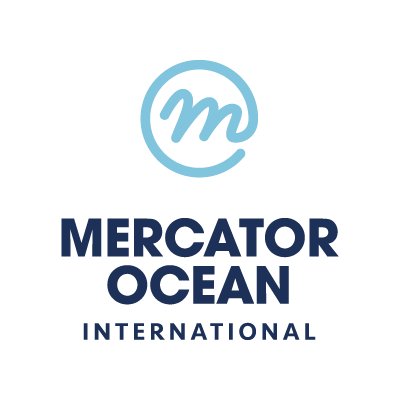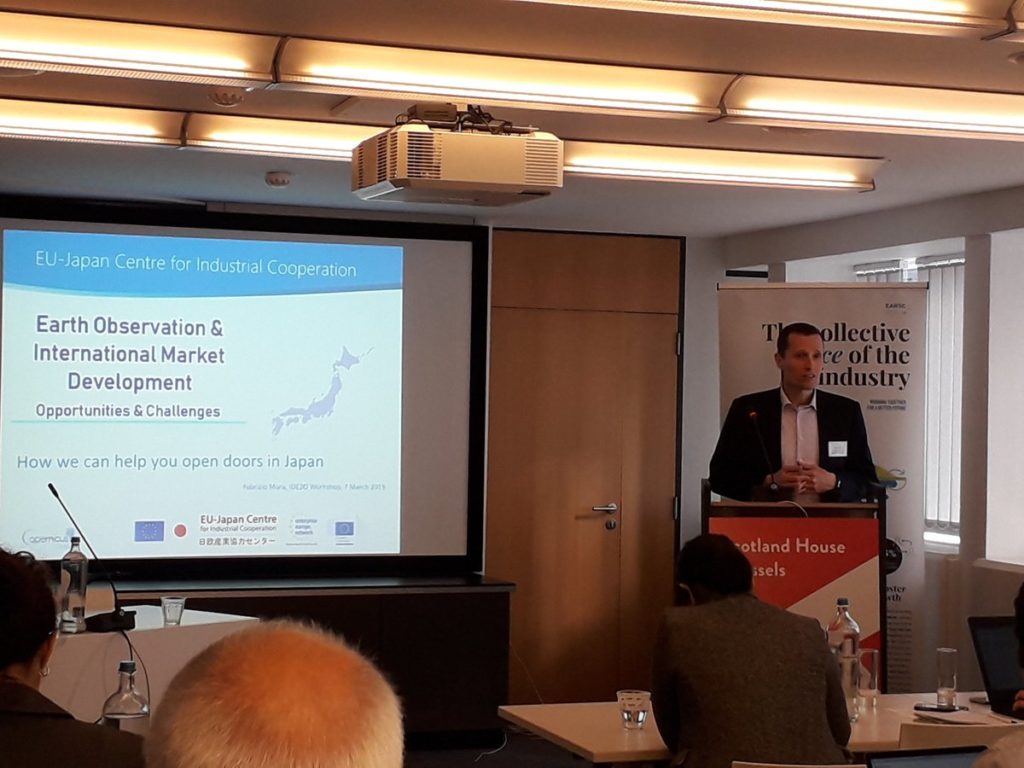
- Short description about the organisation
Mercator Ocean International, based in Toulouse, France, is a global ocean information service operator able to generate digital representations of the world’s oceans. It is one of the world's leading centres for analyzing and forecasting the ocean and delivering operational ocean information worldwide. It is a service provider of ocean data and information in real and delayed time. The digital systems and the global models (of all the oceans on Earth) developed and operated by Mercator Ocean are able to describe the physical and biogeochemical state of the ocean at any time, above and beneath the surface, on the scale of the globe or of a region of the globe: temperature, salinity, currents, sea surface height, ice thickness, chlorophyll, nutrients, etc.
Mercator Ocean International is a non-profit organization with a business neutral objective to empower and feed the EO industry with free of charge environmental and ocean data and supports the EO industry business growth and service development. Mercator Ocean acts as a broker between marine knowledge and ocean data on the one side, and the EO industry on the other side, bringing ocean data and expertise for the benefit of the EO industry and its blue growth.
This general interest mission of the company is funded by its shareholders and by the European Union. Mercator Ocean International is owned and governed by organizations involved in the development of operational oceanography in Europe and ready to support the general interest mission of the company, and entrusted by the European Union for implementing the Copernicus Marine Service.
2. Can you tell us about the growing potential of the Maritime sector?
In the last ten years, following new environmental directives or the impact of climate change for example, the maritime sector has been encouraged to rethink its global strategy, with new production processes and new environmental strategies. This creates new potentials which are tackled by the marine industry. Mercator Ocean International was entrusted by the European Union in 2014 for implementing the marine component of the EU’s Copernicus programme: the Copernicus Marine Environment Monitoring Service. The European EO industry interest in the Copernicus services mainly relies in the Land Service with 57% (see below, extracted from “A survey into the State&Health of the European EO industry, EARSC, 2017). However, the second one is the Copernicus Marine Service with 13% and it has been a continuous objective for all Mercator Ocean experts to incessantly foster a virtuous growth of the maritime sector and operational oceanography for a sustainable ocean, bringing science and technology solutions to society and economy challenges. According to the Copernicus Market report (February 2019, https://www.copernicus.eu/sites/default/files/PwC_Copernicus_Market_Report_2019.pdf, Page7), the ocean monitoring sector shall experience the largest growth rate (+23%) of all sectors up to 2020
Figure1: European EO industry interest in Copernicus services. Credits: A survey into the State&Health of the European EO industry, EARSC, 2017.
The Copernicus Marine Service is delivering free ocean data and information to public and private companies -start-ups, SMEs and large companies (i.e. the EO industry and intermediate users)- which are in turn developing applications, adding value to the Copernicus Marine products and developing services for their own end users, hence developing the blue economy and creating jobs. The Copernicus Marine Service is supporting the marine industry in 10 various sectors: POLAR ENVIRONMENT MONITORING, MARINE CONSERVATION & POLICIES, SCIENCE & CLIMATE, NATURAL RESOURCES & ENERGY, WATER QUALITY, COASTAL MONITORING, SOCIETY & EDUCATION, MARINE FOOD, MARINE NAVIGATION, SAFETY & DISASTER (http://marine.copernicus.eu/markets/).
For example, the MARINE FOOD sector is rethinking the aquaculture of tomorrow. Aquaculture plays a critical role in terms of food, nutrition and employment for millions of people. The sector supports about 10 percent of the world’s population. Aquaculture grows faster than other major food production sectors. In this specific sector, ocean data and information is needed to develop application and services in order to find new sites for production, to adapt its strategy to climate change, to monitor water quality and to transform the aquaculture sector into an environmentally sustainable business.
Another example is the NATURAL RESOURCES & ENERGY sector, which is switching to renewable energy to lower our carbon footprint. A carbon-neutral system means significantly increasing the uptake of renewable energy, with 80-100% of the future electricity supply set to come from clean energy sources. The ocean is a rich resource of clean, predictable energy, and it is needed with the acceleration of the energy transition. Tidal energy, wave energy devices, ocean thermal energy conversion (OTEC) and salinity gradient technologies can deliver non-stop power and can be ramped up or down as needed. In this specific sector, ocean data and information is needed to develop application and services in order to find new sites for production, to test ocean energy prototypes and to secure operations at sea.
Finally, the MARINE NAVIGATION accounts for more than 80% of international freight transport. Ship weather routing is widely used but a more accurate and timely routing using the ocean current forecast and wave data makes it possible to optimize routes and save fuel consumption.
3. What services do you offer?
Mercator Ocean International offers free access to a portfolio of ocean data and information describing the physical and biogeochemical features of European seas and the global ocean. These data describes the ocean circulation (major currents, waves, sea level, etc.), its physical (temperature, salinity, density, etc.) and biogeochemical characteristics (chlorophyll, dissolved oxygen, primary production, etc.) and the state of frozen bodies of sea water at high latitudes (sea ice cover and movements in the Arctic and Antarctica). This European service is recognized today by thousands of users worldwide as a unique source of timely, reliable and state-of-the-art information on the physical and biogeochemical state of the world ocean. A machine to machine service is also available for operational users.
This ocean data service will be upgraded soon with cloud processing capability thanks to the WEkEO DIAS platform.Indeed, Mercator Ocean International, together with EUMETSAT and ECMWF and the support of the industry, is also developing the Copernicus WEkEO DIAS platform (wekeo.eu), offering environmental data and gathering the whole Copernicus portfolio in a single place, also providing with virtual processing environments and skilled user support.
Mercator Ocean International also provides with a reactive and skilled user support. It also organizes scientific meetings for the European and international oceanography community to exchange and share best practices. Moreover, it organizes training workshops in different European countries as well as thematic workshops (for the aquaculture sector for example) where face to face meeting with potential or effective users allow helping them gear up their expertise and develop their applications.
Mercator Ocean International also commits to reaching out to the general public and raising awareness about the ocean challenges and its many pollution risks. Information and tools accessible to the general public are developed and promoted. Finally, Mercator Ocean conducts scientific studies and develops tools in order to model the ocean numerically and assess the impact of ocean observations on such models. Its scientists are developing the state-of-the-art algorithms for a more accurate ocean forecast capacity.
4. How does Mercator Ocean International support small remote sensing companies?
Thanks to its very reactive and skilled user support, along with its business neutral positioning, Mercator Ocean is able to help and support SMEs to develop their applications. Moreover, the ocean data distributed by the Copernicus Marine Service is free of charge, allowing public and private companies – start-ups, SMEs and large companies (i.e. intermediate users) – to develop their applications, adding value to the Copernicus Marine products and developing services for their own end users. Intermediate users represent key assets for the development of the blue economy by revitalizing specialized downstream sectors (environment, transport, research, defense, etc.).
The Copernicus Marine Service supports its intermediate users by promoting their business in many ways, for example in the Use Case web portal section where intermediate users showcase applications they have developed using the Copernicus Marine service products. Publishing such a use case on our web portal help intermediate users to raise awareness of their work as these success stories are widely circulated to local and regional authorities, representatives in the European Parliament, industry chief executives and participants at dedicated events.
We also fund Use Case Demos through the User Uptake Program where key players develop services using Copernicus Marine data and information which serve as exemplary cases to inspire new users.
Moreover, the Copernicus Marine Service is user-driven and we are gathering feedbacks from our intermediate users in many ways (surveys, workshops …) in order to transform our portfolio into fit-for-purpose data for each sector. The Champion User Advisory Group, composed of intermediate users from various sectors, is advising us to improve the Copernicus Marine product and service.
5. What is new at Mercator Ocean International that companies should know about?
Mercator Ocean is constantly evolving and commits to improving its services in the future and fostering a virtuous growth of the maritime sector and operational oceanography.
It has enlarged its shareholding two years ago to new members encompassing European leaders in oceanography such as Puertos del Estado in Spain, CMCC in Italy, NERSC in Norway, and Met Office in the UK to form a multi-national governance with the French founding shareholders – CNRS, Ifremer, IRD, Météo-France and SHOM. This process is ongoing and other organisations are invited to join.
We are also pleased to announce a new Copernicus Marine catalogue release on December 3rd, 2019 that includes much awaited global wave reanalysis product. This is one of the most awaited products by our users, especially from the natural resources & energy and marine navigation sectors. Such product allows assessing the world ocean wave behavior over the last 25 years and pinpoint areas where renewable wave energy farms could be implemented or areas where ship structure and hull endure the worst fatigue for them to be designed accordingly.
Mercator Ocean International has raised its profile with international organisations and programs to better contribute to a successful operational oceanography in Europe and influence structuring initiatives. A new publication called ‘Blue Book’ will be released in November 19 2019 to explain to the general public how ocean data supports the blue economy and societal challenges.
Mercator Ocean also reinforced its partnership strategy with leading trade associations such as EARSC and EATIP for example, in order to better reach out to the EO industry and aquaculture communities respectively and gather their important feedbacks for the future evolution of the service.
6. You offer training session, what can people learn during these sessions and for whom are they?
We organize regional training workshops in different European countries. We also organize thematic workshops (for the aquaculture sector for example). During those workshops, we meet face to face with potential or effective users and help them gear up their marine expertise and develop their applications. We present our offer in details, showcasing some specific relevant products, displaying our web portal and its functionalities. We also organize hands-on sessions using tools such as Jupyter Notebook, so that participants can manipulate data, visualize it and get familiar with data format and data parameters contained in each data files. The objective is for each participant to gain an understanding on the wealth of ocean data available to them, identify opportunities offered by our portfolio and acquire additional skills.
Our ambition is to provide high quality training to those who need to incorporate ocean data to their business, research or projects. Our target audiences are intermediate users from each sector (listed above) from public and private companies -start-ups, SMEs and large companies - which develop applications with the Copernicus Marine products for their own end users. Our target also includes consultant & researchers, MSc and PhD Students in environmental sciences.


